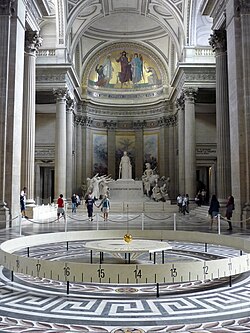
The Foucault pendulum or Foucault's pendulum is a simple device named after French physicist Léon Foucault, conceived as an experiment to demonstrate the Earth's rotation. If a long and heavy pendulum suspended from the high roof above a circular area is monitored over an extended period of time, its plane of oscillation appears to change spontaneously as the Earth makes its 24-hourly rotation.
The pendulum was introduced in 1851 and was the first experiment to give simple, direct evidence of the Earth's rotation. Foucault followed up in 1852 with a gyroscope experiment to further demonstrate the Earth's rotation. Foucault pendulums today are popular displays in science museums and universities.[1]
- ^ Oprea, John (1995). "Geometry and the Foucault Pendulum". Amer. Math. Monthly. 102 (6): 515–522. doi:10.2307/2974765. JSTOR 2974765. Archived from the original on 2015-04-02.